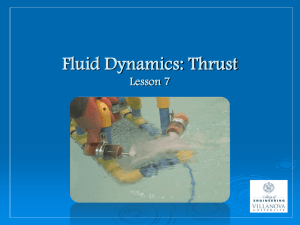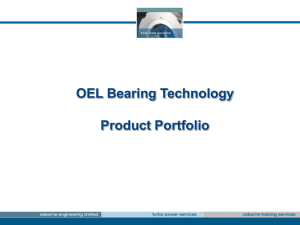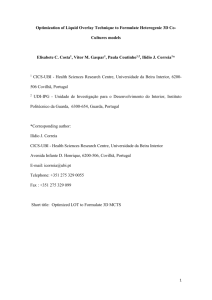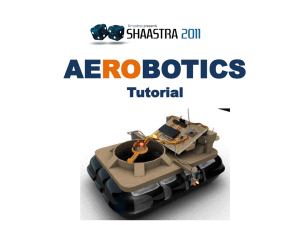Thrust I - Department of Regenerative Medicine and Cell Biology
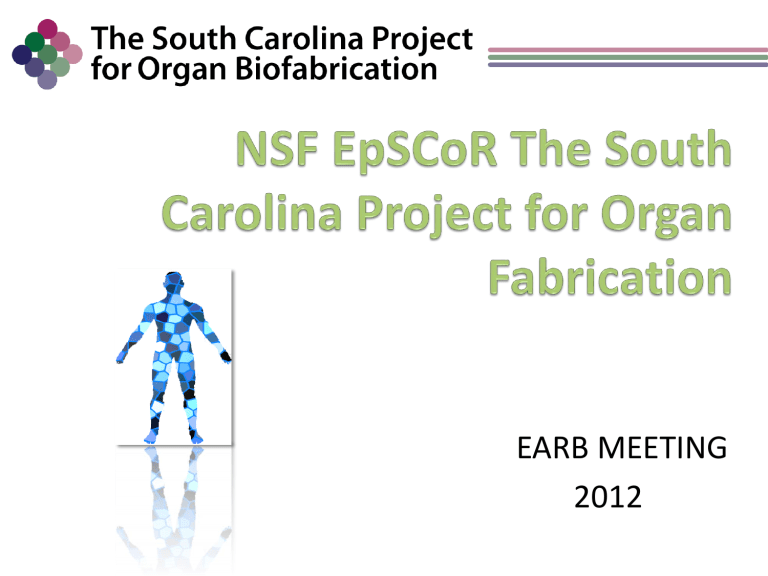
EARB MEETING
2012
Biofabrication by BioPrinting
Advantages
• Precision in positioning cell types
• Scaffold “free” (
What are hydrogels?)
• “Mimics” Development
(vs. expts in evolution)
• Potential for “scale up automation”
• Solves the vascularization problem of thick tissue constructs
Biofabrication by BioPrinting
Disadvantages
• Explosion of interest but unsolved technology
• Few pioneers 2005+
– Boland, Nakamura, Forgacs and their respective groups
Huvec cells survive printer and can be positioned 2D
3D tube printed in 2007 -- 1mm
2007 double layered (Huvec, aortic sm. Muscle) 1mm
2009 10 mm solid structures were printed but collapsed
Technology of great potential looking for new ideas and solutions
NSF RII Thrusts
• Thrust Leaders are tactical leaders who lead teams
• Five Thrusts not Five Silos
• Shared Vision: build vascular constructs
2011-2012 milestone: 4mm X 27mm tubular prototype having 6,000 subunits of living tissue
• All participate in the three steps of biofabrication pre-processing processing postprocessing
TACTICAL APPROACHES
Thrust I – Modeling and Computer-Aided-Design
Mathematical Modeling, Software Design, Programming
Leader: Qi Wang
Members: Brian Canada, Thomas Trusk, William Mondy, Xiaofeng Yang, Xinfeng Liu,
Feng Gu, Xigiang Zheng
Thrust II – BioInk, Approaches to the Building Blocks
Aggregates, Stem Cells, Hydrogels, Differentiation, Endothelialization
Leaders: Chris Drake and Richard Visconti
Members: C. Bi, Agnes Nagy, Xuejun Wen
Thrust III – Biomechanical Testing
Natural Vessels, Collagen Tubes, BioPrinted Tubes
Leader: Michael Sutton
Members: Sue Lessner, Jay Potts, Mike Yost, Tarik Shazly, Esmail Jabbari
Thrust IV – Processing / Printing / Assembly
Manual templates, Izumi-ink jet printing, Laser-printing, Magnetic Assembly,
Microfluidics
Leader: Xuejun Wen
Members: William Mondy, Frank Alexis, Scott Argraves, Yong Huang, Waleed Twal
Thrust V – Maturation
ECM Synthesis, Perfusion, Bioreactors, Scaffolds, Small Molecules
Leader: Scott Argraves
Members: Chris Drake, Waleed Twal, Xuejun Wen, Gear Grantees
NSF RII Thrusts
• Thrust Leaders are tactical leaders who lead teams
• Five Thrusts not Five Silos
• Shared Vision: build vascular constructs
2011-2012 milestone: 4mm X 27mm tubular prototype having 6,000 subunits of living tissue
Major Milestone for Year 3 – bioprint 4.5mm x 27 mm tubular construct
NSF RII Thrusts
• Thrust Leaders are tactical leaders who lead teams
• Five Thrusts not Five Silos
• Shared Vision: build vascular constructs
• All participate in the three steps of biofabrication pre-processing processing post-processing
Modeling
Natural Properties
Thrusts I, III
Computer Aided Design
Virtual Blueprints
Thrust I, IV
I. Pre-processing
Spheroid-Based Vessel
Design Parameters
II.
Spheroid Preparation
Thrusts II, IV, V
Bioprinter/Dispensor
Thrust IV team
Processing
Hydrogels/biomaterials
Thrusts II, IV, V
III.
Directed Differentiation
Thrusts II, V
Post-processing
Perfusion
Endothelialization
Testing
Thrusts , II, III, IV, V
Maturogens
Thrusts II, III, V
All Thrusts Participate in Multiple Steps of Bioprinting
Goals (Milestones) for Year 3
• Develop by mathematical modeling numerical predictive tools for the formation of vascular constructs by the deposition of multicellular aggregates/spheroids in a designer fashion.
– Spearheaded by Qi Wang/Thrust I leader
THRUST 1 PRESENTATION
Leader: Qi Wang
TACTICAL LEADER ------------------ QI Wang
Members: Brian Canada, Thomas Trusk,
William Mondy, Xiaofeng Yang, Xinfeng Liu,
Feng Gu and Xigiang Zheng
Goals (Milestones) for Year 3
• Prepare various types of cell spheroids +/- hydrogels (“BioInk”)
Thrust I: Modeling of hydrogels that bind the cellular spheroids and enrich maturogens
Thrust II : stem cells, ECM, hydrogels (X.Bi, Chas So Univ)
Thrust IV: enhance production (microfluidics, laser assisted )
Thrust V: gelatin microcarrier spheroids: test bed for maturogens etc.
• Build Inkjet type bioprinter to dispense living spheroids
*
Goals (Milestones) Yr 3
• Design and Build an inkjet printer
Designed by Xuejun Wen; assembled by Izumi Inc
.
2 years in the making
β-testing
Bill Mondy with Jorge V. L. Silva, Chief of the Division of Three Dimensional
Technology, Renato Archer Center for Information Technology, Campinas Brazil.
Beta testing (related to Thrust IV)
Early result of printed feature resolution demonstrated by the surface penetration of cardboard on the right and clay on the left. The pliability of clay allowed for smaller feature representation .
An eleven by ten array of physical
impressions, with radii of 36 microns, created in a clay surface by bioprinter’s dispenser.
A B C
A. Series of 1 mm spheres printed during initial testing.
B demonstrates 10 rows of 10 silicone spheres 1 mm in diameter printed in a z stack.
C shows initial testing of bioprinter’s resolvable feature size.
Goals (Milestones) for Year 3
• Translate CAD into coordinates for the cellularized building blocks (spheroids) that can be used by the bioprinter to position (drop) the spheroids at specified locations
– Thrust 1 Team Effort - Bill Mondy
Goals (Milestones) for Year 3
• Dispense and assemble (“print”) living spheroids into variablesized tubular constructs (6 to 6000)
INK JET
Izumi (Wen, Mondy, Dr. Waleed Twal)
Yong Huang (“drop on demand”)
**
OTHER TISSUE ASSEMBLY APPROACHES magnetic particles (Frank Alexis, Xuejun Wen) laser assisted (Yong Huang) **
machined assisted devices/Argraves,Drake,Wen) microfluidics – Xuejun Wen presentation
4 mm x 17mm
Scaffold-free Alginate Tube Fabrication using Inkjet and Laser printing
Presentation
Yong Huang
Department of Mechanical
Engineering
Clemson University, Clemson, SC
Goals (Milestones) for Year 3
• Dispense and assemble (“print”) living spheroids into variable-sized tubular constructs (6-10 to 6000 model )
Izumi (Wen, Mondy et al.)
Yong Huang (“drop on demand”)
**
Other experimental approaches magnetic particles (Frank Alexis) laser assisted (Yong Huang) ** machined assisted devices
Goals (Milestones) for Year 3
• Dispense and assemble (“print”) living spheroids into variable-sized tubular constructs (6-10 to 6000 model )
Izumi (Wen, Mondy et al.)
Yong Huang (“drop on demand”)
Other experimental approaches magnetic particles (Frank Alexis, Xuejun Wen) laser assisted (Yong Huang)
machined assisted devices/Argraves,Wen)
Flow-through Bioreactor Template for 27mm x 4mm tube
This template is designed to allow spheroids to fill a 4mm diameter tube-shaped space, which will allow the flow of media while the spheroids mature enough to be removed from the chamber.
Using a machined construct to arrange “carrier” spheroids into multi-layer tubes (test bed)
Goals (Milestones) for Year 3
• Dispense and assemble (“print”) living spheroids into variable-sized tubular constructs (6-10 to 6000 model )
Ink Jet
Izumi (Wen, Mondy et al.)
Yong Huang (“drop on demand”)
Other experimental approaches magnetic particles (Frank Alexis, Xuejun Wen) laser assisted (Yong Huang)
machined assisted devices/Argraves,Wen)
Microfluidics: Xuejun Wen (Thrust IV leader)
Presentation by
Xuejun Wen
THRUST IV: Microfluidic approach (Spheroid maker* + Spheroid printer)*
Goals (Milestones) for Year 3
• Model and test for viability * and stability of “printed” spheroids/constructs ( all thrusts) * grant opportunities
• Initiate post-processing differentiation and ways to
“endothelialize” tubular constructs (thrust II, V)
• Develop post-processing mechanisms for accelerating stabilization and maturation (focus on ECM) (thrust II, III V )
• Biomechanical testing: cf.natural (authentic) blood vessels to engineered constructs (bioprinted, extruded collagen tubes, etc.
(thrust III )
Presentations
(sequentially)+
• Thrust II - Chris Drake/Rick Visconti
• Thrust V - Scott Argraves
• Thrust III - Mike Sutton/Jay Potts
Preliminary analysis demonstrates that:
• the measured in vivo longitudinal strain differed between the main renal artery and the first branch by a factor of 2 (25% for main renal artery, 12% for first branch)
• the measured in-vivo circumferential strain differed between
the main renal artery and the first branch by a factor of 2
(12% for main renal artery, 25% for first branch).”
Next level - 2013
MondyCAD “Blueprint”
Goals to reach the next level
• Higher resolution CADs
• Translation of CADs into programming for directing printheads (dispensors)
• Modeling & testing the biology of spheroid formation and fusion
• Hydrogel or ECM properties of Spheroids
• Integration of printing (assembly) approaches
• Endothelialization, Differentiation,Maturogens


